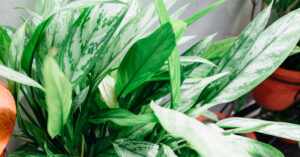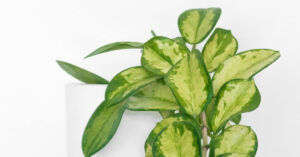Sansevieria trifasciata
Snake Plant stands as the undisputed champion of low-maintenance houseplants, combining striking architectural beauty with legendary indestructibility that has made it a beloved staple in homes for generations. This remarkable specimen delivers bold, sculptural presence while tolerating virtually any condition, making it the perfect choice for anyone seeking dramatic visual impact without the commitment of regular plant care.
Why Snake Plant Earns Its Legendary Status
Native to the arid regions of West Africa, Sansevieria trifasciata has evolved extraordinary survival mechanisms that make it nearly impossible to kill through neglect. Its thick, sword-like leaves store water efficiently while its underground rhizomes provide backup resources, allowing the plant to survive extended droughts that would devastate other houseplants. The plant’s naturally upright, architectural form creates bold vertical lines that work beautifully in modern interiors, making empty corners come alive with sculptural elegance.
What truly sets Snake Plant apart is its unique ability to release oxygen at night, unlike most plants that only produce oxygen during daylight hours. NASA studies have recognized it as one of the top air-purifying plants, effectively removing toxins like formaldehyde, xylene, benzene, and trichloroethylene from indoor air while improving nighttime air quality. This combination of beauty, resilience, and health benefits makes Snake Plant an invaluable addition to bedrooms, offices, and any space needing reliable, beneficial greenery.
Care Requirements
Light Requirements
Low to bright indirect light
Snake Plant demonstrates unparalleled adaptability to virtually any lighting condition, thriving equally well in bright, indirect light and surprisingly dark spaces. It tolerates office fluorescent lighting, north-facing windows, interior hallways, and basement areas where most plants would struggle to survive. The plant can even handle some direct sunlight, though prolonged exposure to intense rays may fade its distinctive patterns. In very low light, growth slows considerably, but the plant maintains its health and appearance indefinitely.
Watering
Very low frequency
The fundamental rule for Snake Plant success is simple: less is always more when it comes to watering. Water only when the soil is completely dry throughout the pot, typically every 2-6 weeks during growing season and even less frequently in winter. The plant’s thick leaves and efficient water storage allow it to survive months without watering, making it perfect for frequent travelers and busy lifestyles. Overwatering causes root rot and is virtually the only way to harm this otherwise indestructible plant.
Soil Type
Fast-draining, well-draining potting mix
Excellent drainage is absolutely crucial for Snake Plant health, as these drought-adapted plants cannot tolerate waterlogged conditions. Use a cactus and succulent potting mix, or create your own by combining regular potting soil with coarse sand, perlite, or pumice in a 1:1 ratio. The soil should drain quickly and completely, never remaining soggy. Choose pots with drainage holes and avoid decorative containers without proper drainage unless you’re experienced with careful watering.
Temperature
60-85°F (15-29°C)
Snake Plant tolerates a remarkably wide temperature range and adapts well to the fluctuations common in most homes and offices. It thrives in typical household temperatures between 60-85°F but can handle brief periods outside this range without damage. The plant shows impressive tolerance for both warm and cool conditions, making it suitable for spaces with less consistent climate control than other tropical houseplants require.
Humidity
Any
Snake Plant requires absolutely no special humidity considerations, performing equally well in dry and humid environments. It excels in the dry air of heated homes, air-conditioned offices, and arid climates without any additional moisture requirements. This complete humidity independence eliminates one of the most common houseplant care challenges and makes it perfect for any environment.
Fertilizing
Minimal to no feeding
Snake Plant has virtually no fertilizer requirements and actually prefers minimal nutrition. The plant can thrive indefinitely without any feeding, and over-fertilizing often causes more harm than good by promoting weak, floppy growth that compromises the plant’s characteristic sturdy appearance. If you choose to fertilize, apply a diluted liquid fertilizer once or twice yearly during growing season, but this is entirely optional.
Seasonal Care Adjustments
Spring/Summer (Growing Season):
- Water every 2-4 weeks when soil is completely dry
- Optional light fertilizing once or twice total
- Ideal time for repotting if absolutely necessary
- Monitor for new shoots emerging from the base
Fall/Winter (Dormant Period):
- Reduce watering to every 6-10 weeks or longer
- No fertilizing needed
- Growth naturally slows or stops—this is completely normal
- Perfect season to appreciate the plant’s sculptural beauty
Mature Size and Growth Habits
Snake Plant typically reaches 2-4 feet in height when mature, though some varieties can grow taller under optimal conditions. The plant grows slowly and steadily, often taking several years to reach full size, which means it maintains its proportions without frequent repotting or management. Individual leaves emerge directly from underground rhizomes and can live for many years, creating dense clusters of upright foliage over time. With minimal care, Snake Plants can live for decades, often producing numerous offsets that create impressive colonies of architectural beauty.
Difficulty Level
Very easy
Snake Plant ranks among the most foolproof houseplants available, requiring minimal attention while tolerating significant neglect. It’s ideal for beginners, frequent travelers, busy professionals, and anyone wanting striking plants without regular maintenance commitments.
Pet and Child Safety
Important: Snake Plant is mildly toxic to pets and children if ingested. The plant contains saponins that can cause nausea, vomiting, and diarrhea. While not typically life-threatening, consumption should be avoided. The plant’s tough, fibrous leaves also present a choking hazard. Keep Snake Plants out of reach of curious pets and small children, or choose pet-safe alternatives if ingestion is a significant concern.
Varieties to Consider
While the classic green Snake Plant with yellow edges remains most popular, several stunning varieties offer unique visual appeal:
- Sansevieria trifasciata ‘Laurentii’: Classic yellow-edged variety with bold striping
- Sansevieria trifasciata ‘Golden Hahnii’: Compact rosette form perfect for small spaces
- Sansevieria cylindrica: Cylindrical leaves that grow in fan patterns
- Sansevieria ‘Moonshine’: Silvery-green leaves with subtle patterns
- Sansevieria ‘Black Gold’: Dark green leaves with bright yellow margins
- Sansevieria ehrenbergii ‘Banana’: Broad, paddle-shaped leaves with yellow edges
Plants That Pair Well with Snake Plant
Snake Plant’s architectural form and minimal care requirements make it an excellent structural element in any plant collection. Its bold, upright presence provides perfect contrast while thriving in conditions that challenge other plants.
Perfect Companions:
- ZZ Plant – Equally indestructible with complementary glossy foliage
- Chinese Evergreen – Similar low-light tolerance with colorful foliage contrast
- Rubber Plant – Comparable architectural presence with different leaf texture
- Aloe Vera – Fellow drought-tolerant succulent with contrasting growth habit
- Peace Lily – Opposite care needs but beautiful aesthetic contrast
Architectural Collections: Create stunning, low-maintenance displays by combining different Snake Plant varieties with other structural plants like ZZ plants, rubber plants, and large dracaenas. These combinations require minimal attention while providing maximum visual impact.
Aesthetic Pairings: Snake Plant serves as an excellent backdrop and anchor plant, providing height and structure while allowing softer, trailing plants like pothos or philodendrons to create beautiful contrast. Its bold vertical lines complement round, bushy plants and add drama to any grouping.
Common Problems and Solutions
Overwatering
Symptoms: Yellow, mushy leaves, root rot, foul-smelling soil, leaf collapse
Solution: Stop watering immediately, improve drainage, remove affected parts, repot if necessary
Underwatering (Extremely Rare)
Symptoms: Wrinkled, deflated leaves, extremely dry soil for extended periods
Solution: Water thoroughly and establish proper drying cycle between waterings
Too Much Water Frequency
Symptoms: Soft, floppy growth, loss of rigidity, yellowing from base
Solution: Reduce watering frequency significantly and improve soil drainage
Physical Damage
Symptoms: Broken or damaged leaf tips, torn leaves from handling
Solution: Trim damaged portions cleanly; leaves will not regrow but plant remains healthy
Normal Aging
Symptoms: Occasional yellowing of oldest leaves
Solution: This is natural – simply remove yellowed leaves at soil level
Propagation
Snake Plant propagation is straightforward and offers multiple methods, making it easy to expand your collection or share with friends:
Division Method (Fastest):
- Remove plant from pot during repotting
- Locate natural divisions with roots attached
- Gently separate rhizomes with sharp, clean knife if needed
- Plant divisions in well-draining soil
- Water sparingly until new growth appears
- New plants establish quickly with this method
Leaf Cutting Method:
- Cut healthy leaves into 3-4 inch sections during growing season
- Mark which end was closest to soil (important for proper orientation)
- Allow cut surfaces to dry for 24-48 hours
- Plant bottom ends in well-draining soil mix
- Keep lightly moist in bright, indirect light
- Roots and new shoots develop in 4-8 weeks
Water Propagation:
- Cut leaf sections as above
- Place in water with bottom ends submerged
- Change water weekly to prevent rot
- Roots develop in 3-4 weeks
- Plant in soil once roots are well-established
Maximizing Architectural Impact
Snake Plant’s bold form makes it perfect for creating dramatic design statements when positioned and grouped thoughtfully.
Single Specimen Display: Use large, mature Snake Plants as living sculptures in corners, beside furniture, or as room dividers. Their vertical lines create striking focal points that draw the eye upward.
Grouping Strategies: Combine multiple Snake Plants of varying heights to create layered, forest-like displays. Mix different varieties for added visual interest while maintaining the cohesive architectural theme.
Container Selection: Choose containers that complement the plant’s bold form—sleek modern planters, substantial ceramic pots, or geometric containers that echo the plant’s clean lines.
Height Variation: Use plant stands or elevated surfaces to create varying heights in Snake Plant groupings, emphasizing their vertical nature and creating more dynamic displays.
Lighting Enhancement: Position uplighting or spotlights to emphasize the plant’s sculptural qualities and create dramatic shadows that enhance its architectural presence.
Your Foundation for Foolproof Plant Success
Snake Plant represents the perfect foundation for any plant collection, offering bold architectural beauty that requires virtually no maintenance while providing genuine health benefits. Its legendary tolerance for neglect, combined with striking visual impact and air-purifying qualities, makes it an invaluable addition to homes, offices, bedrooms, and any space needing reliable, beneficial greenery.
Whether you’re building your first plant collection, seeking plants that survive frequent travel, or wanting dramatic architectural elements that thrive on neglect, Snake Plant delivers unwavering success with minimal effort. Start with this bulletproof beauty, and you’ll discover the confidence that comes from having plants that truly improve your space while asking for almost nothing in return—the ultimate expression of high-impact, low-maintenance plant parenthood.




